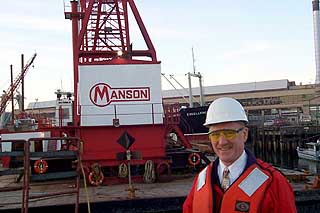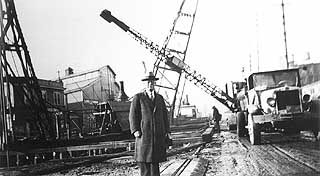|
Subscribe / Renew |
|
|
Contact Us |
|
| ► Subscribe to our Free Weekly Newsletter | |
| home | Welcome, sign in or click here to subscribe. | login |
Construction
| |

December 7, 2000
Challenges of maritime work fuel Manson
Journal Staff Reporter
Many companies spring to mind as emblematic of Seattle's growth in the last century, but in an area that defines itself by its relationship to water, the path of maritime construction company Manson Construction in many ways mirrors the region.

|
While not an international icon like a Boeing, Weyerhaeuser or Microsoft, the 95-year-old company helped build the infrastructure we rely on today.
Manson sports a lengthy resume of projects in and around the water. From Colman Dock to the other terminals of the state ferry system, to the Navy's home port at Everett, to the Seattle Aquarium and the expansion of the Port of Seattle, Manson drove the piles, did the dredging and built the piers.
Along with the size of its projects, the size of Manson's work fleet has grown substantially over the years. Manson began in 1905 with a floating pile driver constructed by Swedish immigrant Peter Manson. Today the firm has a virtual armada of floating work boats including 20 floating cranes, three hopper dredges, six cutter suction dredges, 15 tugboats and 50 barges.
Still privately held, Manson currently has about 400 employees.
Right now, says Patrick McGarry, Manson vice president for operations, half of the firm's work is in dredging, with the balance being a variety of construction work.

|
And though the firm does do international projects in Mexico and South America, McGarry said, "The greatest amount of our work is in the U.S., and the bulk of that is on the West Coast."
Manson's expansion -- the company has offices in Seattle; Richmond, Calif.; Long Beach, Calif.; and a subsidiary, Manson Gulf, in Houma, La. -- has allowed the firm to weather the turmoil caused by increased environmental regulation in the Puget Sound area.
Army Corps of Engineers permits are required for work in the water. Because of the listing of chinook salmon as threatened under the Endangered Species Act, these permits now undergo potentially lengthy "endangered species review."
As of a few weeks ago, the Seattle district office of the Corps had over 1,000 backlogged permits awaiting action.
"For our company," says McGarry, "it has not been a big issue." But there has been frustration with the delays, he said.
"We all need to step up to the plate to play a role in the recovery of salmon," he said. But "delays like this aren't helping salmon."
McGarry is hopeful about new permit streamlining procedures announced by the Corps late last month that will allow speedier processing of small projects.
In terms of the firm's overall commitment to the environment, McGarry maintains, "We've always tried to stay ahead of the curve."
He cites the fact that every Manson vessel carries an oil-spill response kit, something that is not required. Additionally, Manson is a contractor to the Marine Spill Response Corp. in Everett.
While the firm would stand to make some money should it be called upon by MSRC, the amount of employee training required to become part of the response team is beneficial to Manson's own operations, McGarry says.
Because of the company's work in Southern California, Manson is upgrading engines throughout its fleet to a higher-efficiency diesel type. These lower emission engines are required in Southern California, but not elsewhere.
Manson's floating crane Njord is capable of all-electric operation with a diesel generator on board. If need be, it can hook up to a barge acting as an "extension cord" to a land-based power source.
According to McGarry, this can prove valuable to areas struggling with emissions problems like Houston or Los Angeles. While powered electrically, the Njord is capable of operating a 50 cubic yard bucket, which Manson says is the largest clamshell bucket on the West Coast.
The Njord is currently working in the San Francisco Bay area where Manson is working on one of its larger projects: Berths 57 and 58, for the Port of Oakland. The $50 million project encompasses 150 acres and may eventually accommodate up to six container cranes.
Also in California, Manson is working on a Port of Long Beach project that's also valued at about $50 million. Pier T, as it's known, is on the site of the former Long Beach Naval Station and Shipyard. When complete it will serve as a container terminal for the Hanjin Shipping Co. of South Korea under a 25-year, $1 billion lease.
Despite such national megaprojects, Manson maintains much of its small company feel. There are third generation employees working there.
"People tend to stay," says McGarry, a 30-year employee whose son works for the firm.
When things get slow, Manson often puts employees to work building and modifying its ships on the Duwamish.
"You can't just go out and buy a floating crane," says McGarry.
But with resourcefulness, you can make one. Just as you can build a company starting with a steam engine on a scow nearly a century ago.
Previous columns:
- Flash Gordon meets the backhoe, 11-30-2000
- Vegetated rooftops are taking root, 11-16-2000
- Seattle firm focuses on keeping concrete clean, 11-09-2000
- New span bridges the past, 11-02-2000
- Constructive education, 10-26-2000
- New furniture line departs from the norm, 10-19-2000
- Green shingles may be no match for gray weather, 10-12-2000
- Builders, counties partner for green homes, 10-05-2000


